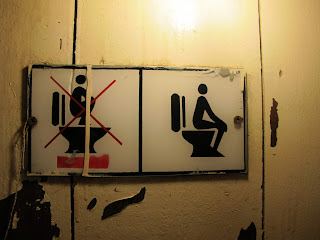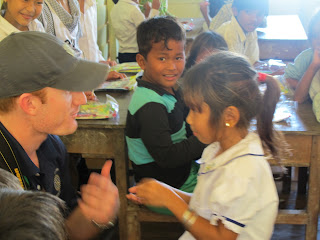I'm writing (most) of this on Thanksgiving day, at least in the time zone I am in. No cranberry sauce for me though, but I did enjoy a nice buffet dinner and Cambodian culture show with some great Rotarians. I travelled to Siem Reap with a Rotary group from Malaysia in their 8th year of providing humanitarian aid to Cambodia. This year focused on delivering school and medical supplies to floating villages on Lake Tonle Sap. This is the largest freshwater lake in SE Asia and is very unique for many reasons, one being that it grows and shrinks dramatically during the wet and dry seasons. With huge biodiversity, this lake provides at least 60% of Cambodians protein intake. Cambodia relies on the river for a majority of its economy and this is threatened by the proposal of construction of huge dams in Laos to supply energy for the growing demands of the region.
The lake is very high right now as it is just the beginning of the dry season so we took a 2 hour boat ride to reach the floating village of Mont Kla. This comprises about 200 people and it moves up to 6 times a year as the water levels change, the villages go with the flow and move about in location. We visited a floating school and then the chiefs house which serves as a medical office when The Lake Clinic (a medical boat) comes to town, which is about once every 2 weeks. It was a very humbling experience to visit the school children and witness the conditions that people live in.
Additionally, and most interesting to me, was learning about installing biosand filtration units to provide clean drinking water for the residents. They are surrounded by water, but also use it as a toilet. The biosand filters are relatively simple units which filter out 99% of the harmful bacteria if used properly and maintained. They range in price from $50-$70 USD and can be produced from all local materials. Over 7,000 have been installed in the Siem Reap province area with about 115 installed in homes on the lake and many more to come. Residents are asked to pay about $7 USD and sign a contract to receive a water filter unit. The next day we also were able to visit the production facility and laboratory where the filters are assembled and tested run through an organization called Clean Water for Cambodia (http://www.waterforcambodia.org/).
Of course you can't come to Cambodia and not visit the temples of Angkor. We spent 2 whole days (including a beautiful sunrise and sunset) exploring some of the main temples including one of the 7 Wonders of the World…Angkor Wat; this is the world’s largest religious building. These temples were built by a series of ‘god-kings’ with each trying to outdo the last from AD 802 to 1432. There is a lot of history here I would be doing an injustice in trying to explain it, but hopefully the photos can inspire you to learning some more about it on your own. One interesting fact is that this empire changed from Hinduism to Buddhism and then back to Hinduism again so the temples depict deities from both religions.
But alas, one of the reasons these temples were abandon and left to the elements in 1432 was WATER! The ancient Khmers (Cambodian people) mastered the cycle of nature to water their lands by building reservoirs and irrigation systems for this hydraulic city which did not naturally lie near a river or water body. By the time Angkor Wat was completed the hydraulic system which supported agriculture had been pushed beyond its limits and was starting to silt up due to overpopulation and deforestation. The construction of Angkor Wat was a strain on resources and eventually the society that was based there declined and the capital was moved to Phnom Penh. The temples of Angkor were re-discovered in the early 1900s.
Myself and two others stuck around for a few days after the Rotary group left which was great because it gave us time to enjoy sunset horseback riding through the rice paddies and pagodas outside of the city, spend more time at the temples, indulge in cheap massages (seriously, $5USD for 1 hour massage), explore the markets, and even finally test our tickle tolerance at a “fish spa.”
This trip was a wonderful way to meet and get to know many Rotarians and friends of Rotary while learning about and taking part in service projects. I am grateful every day for the opportunities Rotary has opened for me and I look forward to the next nine months of learning and travel ahead!
Of course I have a million photos from this adventure, I’ll post some highlights here and try and make a slide show to post when I get back to KL soon!
 |
| These are actually the first elephants I've seen since my arrival in SE Asia. |
 |
| The many faces of Bayon temple, Angkor Thom. |
 |
| At least they had decent public restrooms throughout, just in case you weren't sure of proper use for this style of toilet, there was a friendly reminder. |
 |
| Ta Prohm |
 |
| Angkor Wat. |
 |
| These figures are called Apsaras and are carved throughout the the temples. They are considered heavenly nymphs, spirits of the clouds and waters, and are usually associated with fertility. |
 |
| Buddhist monks passing through a floating village on Lake Tonle Sap. |
 |
| Andrew interacting with Cambodian school children in their floating school after we donated school supplies for 400 students. |
 |
| Now they can learn geography! |
 |
| We happened to be wrapping up as the lunch out arrived and the children came running out of the school and hopped on boats to paddle home for the afternoon. |
 |
| Installing a new light weight biosand drinking water filter unit in a small floating home. |
 |
| Floating home on Lake Tonle Sap, trying to build another next door. |
 |
| Some amazing waterfalls on the River of a Thousand Lingas. |
 |
| Testing our nerves at the fish spa. A very interesting feeling indeed, little fish going to town on your dirty feet. |
 |
| Scene from the horse ride. |
 |
| Angkor Wat sunrise. |
 |
| Bayon temple in the late afternoon light. |
 |
| Sunset atop the temple atop Bakheng Hill. Great shot by one of my travel companions, it was difficult to shoot over the heads of the hundreds of tourists that were sharing the experience with us. |





No comments:
Post a Comment